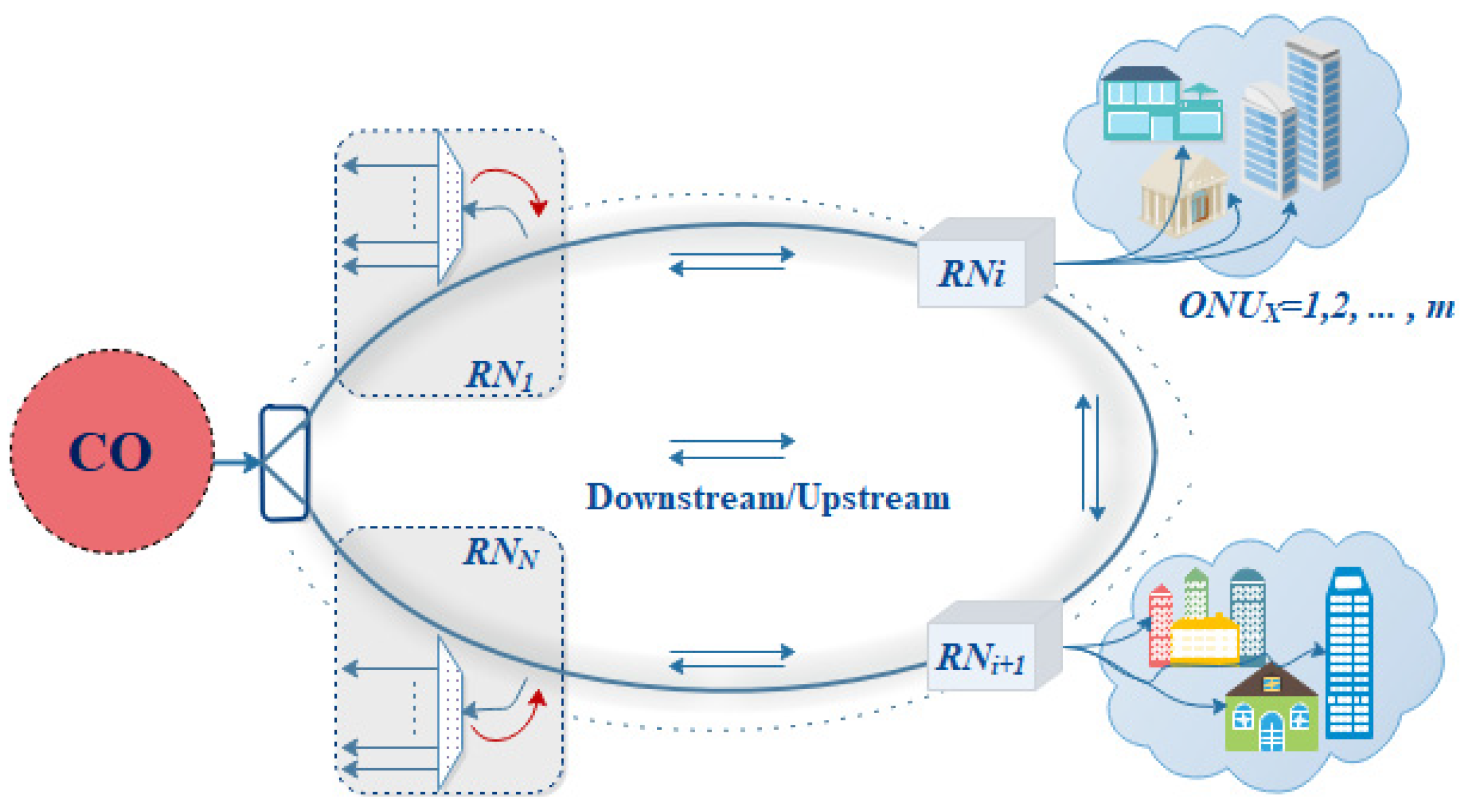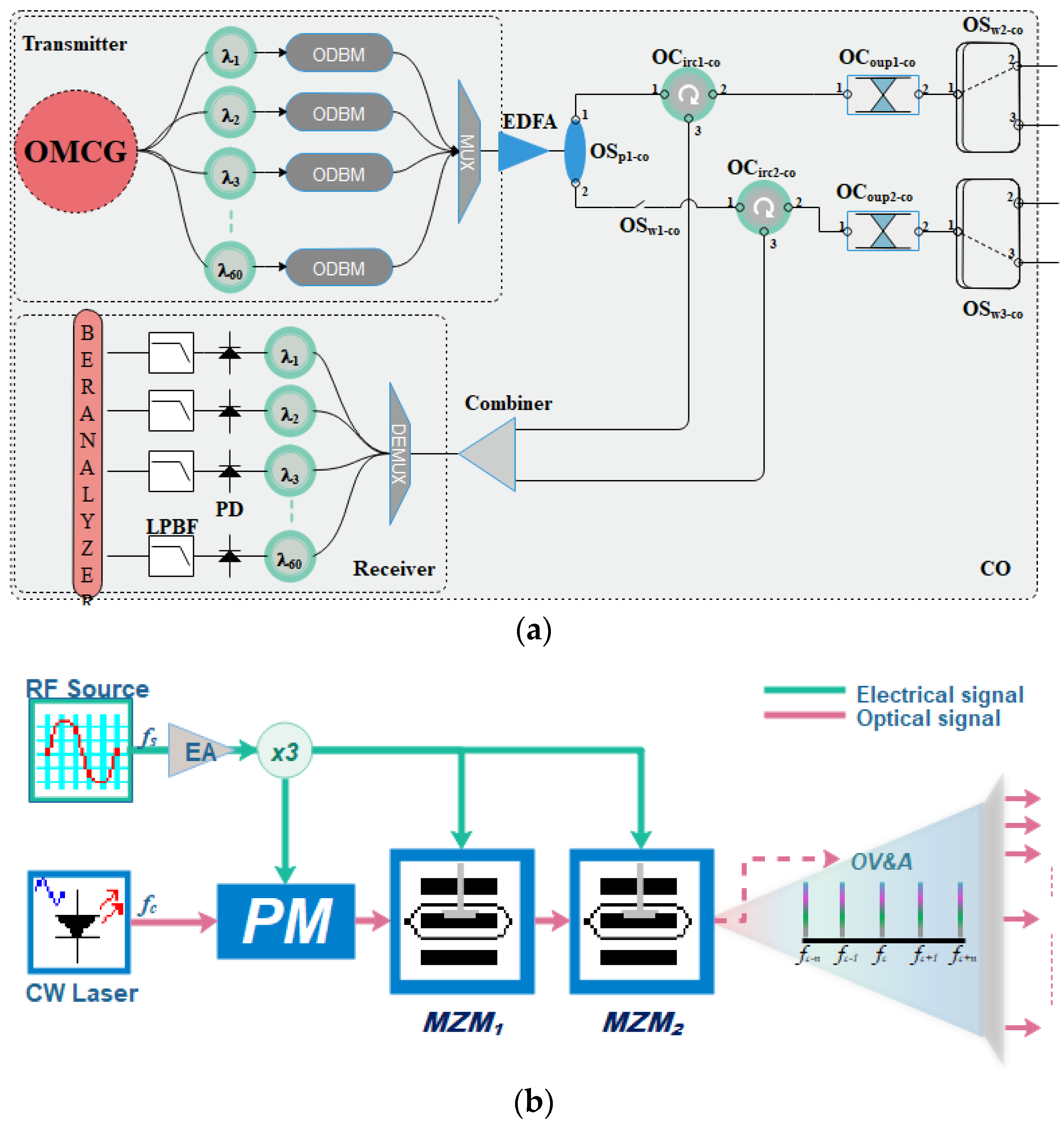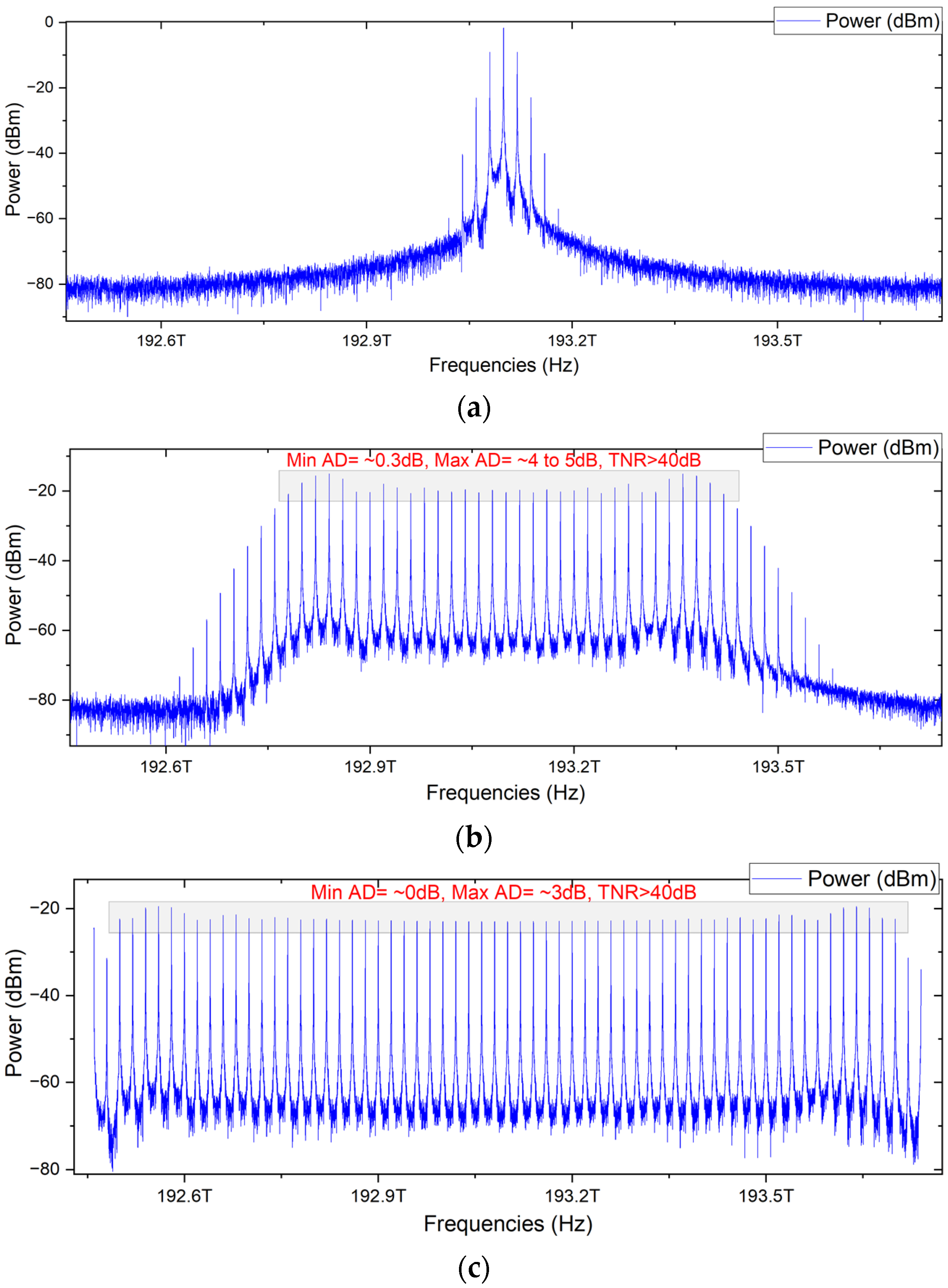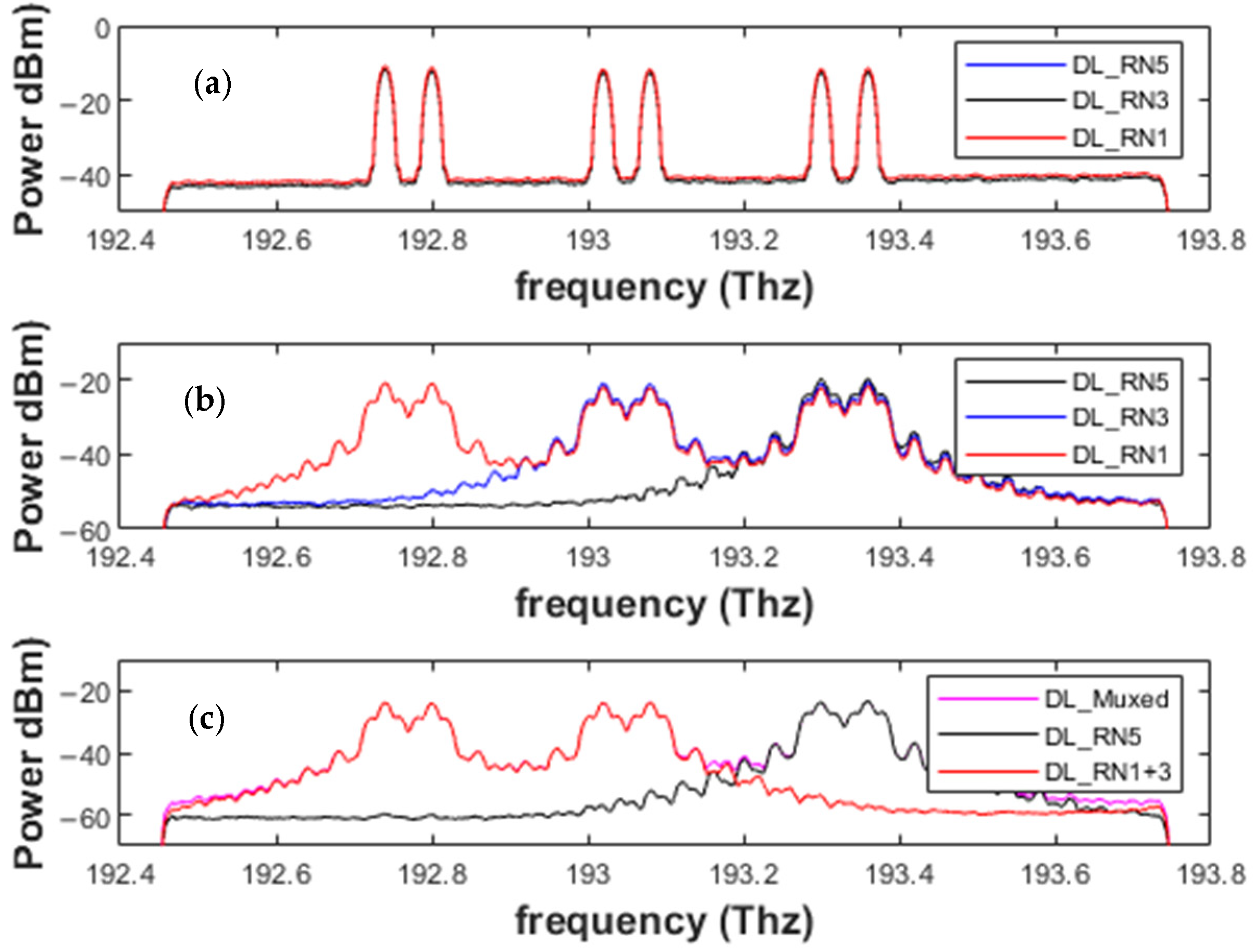A High-Capacity Optical Metro Access Network: Efficiently Recovering Fiber Failures with Robust Switching and Centralized Optical Line Terminal
Abstract
1. Introduction
- This study proposes a new central office for an OMAN based on an OMC generator, focusing on affordability and an efficient switching system.
- The OMCG is based on a cascaded configuration of a phase modulator (PM) and two Mach Zehnder modulators (MZMs), driven by an RF signal controlling the carriers’ frequency spacing. Over sixty frequencies are generated with a high tone-to-noise ratio (TNR) of 40 dB and minimal amplitude difference among the generated carriers.
- An efficient switching mechanism is introduced in the proposed OMAN to handle the transmissions during the fiber failures in the main core fiber in the ring architecture. This failure could be a single fiber failure or a multistage fiber failure, which are also considered and presented for proper maintenance/management of the transmission. The proposed CO design can cope with different scenario-based problems without compromising the transmission quality.
2. Architecture of the Proposed Optical Metro Access Network
2.1. Schematic of the CO
2.2. The Principal of the OMC Generator
3. Downlink and Uplink Transmission Operations
4. Protection Mechanism
5. Conclusions
Author Contributions
Funding
Institutional Review Board Statement
Informed Consent Statement
Data Availability Statement
Conflicts of Interest
References
- Pan, B.; Xue, X.; Guo, X.; Calabretta, N. Precise time distribution and synchronization for low latency slotted optical metro-access networks. J. Light. Technol. 2022, 40, 2244–2253. [Google Scholar] [CrossRef]
- Hall, M.N.; Foerster, K.-T.; Schmid, S.; Durairajan, R. A survey of reconfigurable optical networks. Opt. Switch. Netw. 2021, 41, 100621. [Google Scholar] [CrossRef]
- Zhang, C.; Zhang, Q.; Chen, C.; Jiang, N.; Liu, D.; Qiu, K.; Liu, S.; Wu, B. Metro-access integrated network based on optical OFDMA with dynamic sub-carrier allocation and power distribution. Opt. Express 2013, 21, 2474–2479. [Google Scholar] [CrossRef] [PubMed]
- Filgueiras, H.R.D.; Lima, E.S.; Cunha, M.S.B.; Lopes, C.H.D.S.; De Souza, L.C.; Borges, R.M.; Pereira, L.A.M.; Brandão, T.H.; Andrade, T.P.V.; Alexandre, L.C. Wireless and Optical Convergent Access Technologies Toward 6G. IEEE Access 2023, 11, 9232–9259. [Google Scholar] [CrossRef]
- Yang, H. Optical and wireless convergence network based on blockchain. In Security Issues in Fog Computing from 5G to 6G: Architectures, Applications and Solutions; Springer: Berlin/Heidelberg, Germany, 2022; pp. 131–143. [Google Scholar]
- Xia, J.; Li, T.; Cheng, Q.; Glick, M.; Crisp, M.; Bergman, K.; Penty, R. A future proof reconfigurable wireless and fixed converged optical fronthaul network using silicon photonic switching strategies. J. Light. Technol. 2022, 41, 1610–1618. [Google Scholar] [CrossRef]
- Feng, N.; Ma, M.; Li, Z.; Li, S.B. Flexible Media Access Control Layer Key Technologies for Elastic Optical Access Network. In Proceedings of the 2023 21st International Conference on Optical Communications and Networks (ICOCN), Qufu, China, 31 July–3 August 2023; IEEE: Piscataway, NJ, USA, 2023; pp. 1–3. [Google Scholar]
- Layec, P.; Dupas, A.; Verchère, D.; Sparks, K.; Bigo, S. Will metro networks be the playground for (true) elastic optical networks? J. Light. Technol. 2017, 35, 1260–1266. [Google Scholar] [CrossRef]
- Li, X.; Gan, C.; Yan, Y.; Qiao, H. Grid architecture of a metro-access optical network to support discretionary peer-to-peer intracommunication and intercommunication between ONUs. J. Opt. Commun. Netw. 2019, 11, 130–139. [Google Scholar] [CrossRef]
- Ruffini, M.; Achouche, M.; Arbelaez, A.; Bonk, R.; Di Giglio, A.; Doran, N.J.; Furdek, M.; Jensen, R.; Montalvo, J.; Parsons, N.; et al. Access and metro network convergence for flexible end-to-end network design [invited]. J. Opt. Commun. Netw. 2017, 9, 524–535. [Google Scholar] [CrossRef]
- Pato, S.; Borges, N.; Pedro, J. Capacity prospects of future high density metro-access networks. In Proceedings of the 2013 15th International Conference on Transparent Optical Networks (ICTON), Cartagena, Spain, 23–27 June 2013. [Google Scholar]
- Gou, K.; Gan, C.; Zhang, X.; Zhang, Y. A tangent-ring optical TWDM-MAN enabling three-level transregional reconfigurations and shared protections by multipoint distributed control. Opt. Commun. 2018, 410, 855–862. [Google Scholar] [CrossRef]
- Bianco, A.; Bonald, T.; Cuda, D.; Indre, R.M. Cost, power consumption and performance evaluation of metro networks. J. Opt. Commun. Netw. 2013, 5, 81–91. [Google Scholar] [CrossRef]
- Guo, Y.; Gan, C.; Zhan, N. A novel expandable intersection-ring architecture supporting optical network units’ discretionary peer-to-peer communication in metro-access network. Int. J. Commun. Syst. 2022, 35, e5079. [Google Scholar] [CrossRef]
- Li, X.; Gan, C.; Chen, Y.; Qiao, H.; Yan, Y. Dual-Fiber-Ring Architecture Supporting Discretionary Peer-to-Peer Intra-Communication and Bidirectional Inter-communication in Metro-Access Network. IEEE Access 2019, 7, 52360–52370. [Google Scholar] [CrossRef]
- Lafata, P. Protection of passive optical network by using ring topology. In Proceedings of the 2012 35th International Conference on Telecommunications and Signal Processing, Prague, Czech Republic, 3–4 July 2012. [Google Scholar]
- Kaszubowska-Anandarajah, A.; Ahmad, S.T.; Roeloffzen, C.G.H.; van Dijk, P.W.L.; Sharma, A.; Srivastava, M.; Lakshmijayasimha, P.D.; Pascual, M.D.G.; Smyth, F.; Braddell, J. Reconfigurable photonic integrated transmitter for metro-access networks. J. Opt. Commun. Netw. 2023, 15, A92–A102. [Google Scholar] [CrossRef]
- Lakshmijayasimha, P.D.; Kaszubowska-Anandarajah, A.; Martin, E.P.; Landais, P.; Anandarajah, P.M. Expansion and phase correlation of a wavelength tunable gain-switched optical frequency comb. Opt. Express 2019, 27, 16560–16570. [Google Scholar] [CrossRef] [PubMed]
- Zhou, J.; Ban, X.; Zhang, J.; Li, J.; Yang, J.; Jia, D.; Ge, C.; Wang, Z. Ultra-flat multicarrier light source based on recirculating frequency shift loop driven by a parity–time symmetric optoelectronic oscillator. Appl. Opt. 2023, 62, 6857–6863. [Google Scholar] [CrossRef] [PubMed]
- Das, B.; Mallick, K.; Mandal, P.; Dutta, B.; Barman, C.; Patra, A.S. Flat optical frequency comb generation employing cascaded dual-drive Mach-Zehnder modulators. Results Phys. 2020, 17, 103152. [Google Scholar] [CrossRef]
- Ullah, R.; Ullah, S.; Khan, G.Z.; Mao, Y.; Ren, J.; Zhao, J.; Chen, S.; Li, M.; Khan, J. Ultrawide and tunable self-oscillating optical frequency comb generator based on an optoelectronic oscillator. Results Phys. 2021, 22, 103849. [Google Scholar] [CrossRef]
- Ullah, R.; Bo, L.; Ullah, S.; Yaya, M.; Tian, F.; Xiangjun, X. Cost effective OLT designed from optical frequency comb generator based EML for1. 22 Tbps wavelength division multiplexed passive optical network. Opt. Fiber Technol. 2018, 43, 49–56. [Google Scholar] [CrossRef]
- Ullah, R.; Ullah, U.; Ullah, S.; Al-atawi, A.A.; Alwageed, H.S.; Chen, S.; Ren, J. Dual Electro-Optic Comb Generator by Heterodyning Two Combs for Extending the Optical Bandwidth. IEEE Photonics Technol. Lett. 2023, 35, 1186–1189. [Google Scholar] [CrossRef]
- Lakshmijayasimha, P.D. Reconfigurable Multi-Carrier Transmitters and Their Application in Next Generation Optical Networks. Ph.D. Thesis, Dublin City University, Dublin, Ireland, 2022. [Google Scholar]
- Llorente, R.; Fito, V.; Morant, M. Optical combs and multicore fiber as technology enablers for next-generation datacenter infrastructure. In Proceedings of the Metro and Data Center Optical Networks and Short-Reach Links V; SPIE: Philadelphia, PA, USA, 2022; Volume 12027, pp. 54–63. [Google Scholar]
- Ullah, R.; Ullah, S.; Imtiaz, W.A.; Khan, J.; Shah, P.M.A.; Kamran, M.; Ren, J.; Chen, S. High-Capacity Free Space Optics-Based Passive Optical Network for 5G Front-Haul Deployment. Photonics 2023, 10, 1073. [Google Scholar] [CrossRef]
- Jin, W.; Zhang, C.; Chen, C.; Zhang, Q.; Qiu, K. Scalable and reconfigurable all-optical VPN for OFDM-based metro-access integrated network. J. Light. Technol. 2014, 32, 318–325. [Google Scholar] [CrossRef]
- Ionin, A.A.; Kinyaevskiy, I.O.; Klimachev, Y.M.; Sagitova, A.M.; Andreev, Y.M. CO laser sum-frequency comb for atmosphere sensing. Infrared Phys. Technol. 2019, 100, 62–66. [Google Scholar] [CrossRef]
- Cai, Y.; Cheng, J.; Yan, Y. Spectrum-efficient optical drop-add-drop network with a centralized multi-carrier light source. Photonic Netw. Commun. 2014, 27, 89–98. [Google Scholar] [CrossRef]
- Matsuura, M.; Oki, E. Multi-carrier distributed WDM ring network based on reconfigurable optical drop-add-drop multiplexers and carrier wavelength reuse. In Proceedings of the IEEE International Conference on Communications, Cape Town, South Africa, 23–27 May 2010. [Google Scholar]
- Pan, B.; Yan, F.; Xue, X.; Magelhaes, E.; Calabretta, N. Latency Study of Fast Optical Add-Drop Multiplexer Based Metro Access Network with Edge Computing for 5G Applications. In Proceedings of the OECC/PSC 2019—24th OptoElectronics and Communications Conference/International Conference Photonics in Switching and Computing 2019, Fukuoka, Japan, 7–11 July 2019. [Google Scholar]
- Pan, B.; Yan, F.; Xue, X.; Magelhaes, E.; Calabretta, N. Performance assessment of a fast optical add-drop multiplexer-based metro access network with edge computing. J. Opt. Commun. Netw. 2019, 11, 636–646. [Google Scholar] [CrossRef]
- Miao, W.; De Waardt, H.; Calabretta, N. Optical Label Switching Add-Drop Multiplexer for High-Performance Metro Networks. IEEE Photonics Technol. Lett. 2016, 28, 1065–1068. [Google Scholar] [CrossRef]
- Lin, C.; Wang, Y.; Wang, Y.; Wang, D.; Xiong, F.; Zhang, D.; Zhang, J.; Wang, A.; Du, P.; Peng, X. Multi-carrier broadband signal generation based on a mutually dual-domain mode-locked optoelectronic oscillator. Opt. Commun. 2023, 529, 129094. [Google Scholar] [CrossRef]
- Muciaccia, T.; Gargano, F.; Passaro, V.M.N. Passive optical access networks: State of the art and future evolution. Photonics 2014, 1, 323–346. [Google Scholar] [CrossRef]
- Chiuchiarelli, A.; Proietti, R.; Presi, M.; Choudhury, P.; Contestabile, G.; Ciaramella, E. Symmetric 10 Gb/s WDM-PON based on a cross wavelength-reusing scheme to avoid rayleigh backscattering and maximize band usage. In Proceedings of the 2009 IEEE LEOS Annual Meeting Conference Proceedings, Belek-Antalya, Turkey, 4–8 October 2009; IEEE: Piscataway, NJ, USA, 2009; pp. 555–556. [Google Scholar]
- Cho, K.-Y.; Hong, U.-H.; Jung, S.-P.; Takushima, Y.; Agata, A.; Sano, T.; Horiuchi, Y.; Suzuki, M.; Chung, Y.-C. Long-reach 10-Gb/s RSOA-based WDM PON employing QPSK signal and coherent receiver. Opt. Express 2012, 20, 15353–15358. [Google Scholar] [CrossRef]








| RNX | Frequencies per RN | Frequency Ranges (20 GHz Frequency Spacing) |
|---|---|---|
| RN1 | F01 to F 10 | 192.52 THz→192.7 THz |
| RN2 | F11 to F20 | 192.72 THz→192.9 THz |
| RN3 | F21 to F30 | 192.92 THz→193.1 THz |
| RN4 | F31 to F40 | 193.12 THz→193.3 THz |
| RN5 | F41 to F50 | 193.32 THz→193.5 THz |
| RN6 | F51 to F60 | 193.52 THz→193.7 THz |
| Parameter | Value | Parameter | Value |
|---|---|---|---|
| Global Parameters | Optical Fiber | ||
| Bit rate | 20 × 109 bit/s | Reference wavelength | 1552 nm |
| Sequence length | 256 bits | Length | 5 km |
| Samples per bit | 128 | Attenuation | 0.2 dB/km |
| Symbol rate | 10 × 109 | Dispersion | 16.75 ps/nm/km |
| CW Laser | Dispersion slope | 0.075 ps/nm2/km | |
| Frequency | 193.1 THz | Differential group delay | 0.2 ps/km |
| Power | 5 dBm | Effective area | 80 um2 |
| Linewidth | 0.1 MHz | Fract. Raman contribution | 0.18 |
Disclaimer/Publisher’s Note: The statements, opinions and data contained in all publications are solely those of the individual author(s) and contributor(s) and not of MDPI and/or the editor(s). MDPI and/or the editor(s) disclaim responsibility for any injury to people or property resulting from any ideas, methods, instructions or products referred to in the content. |
© 2024 by the authors. Licensee MDPI, Basel, Switzerland. This article is an open access article distributed under the terms and conditions of the Creative Commons Attribution (CC BY) license (https://creativecommons.org/licenses/by/4.0/).
Share and Cite
Ullah, R.; Ullah, S.; Almadhor, A.; Alwageed, H.S.; Al-Atawi, A.A.; Ren, J.; Chen, S. A High-Capacity Optical Metro Access Network: Efficiently Recovering Fiber Failures with Robust Switching and Centralized Optical Line Terminal. Sensors 2024, 24, 1074. https://doi.org/10.3390/s24041074
Ullah R, Ullah S, Almadhor A, Alwageed HS, Al-Atawi AA, Ren J, Chen S. A High-Capacity Optical Metro Access Network: Efficiently Recovering Fiber Failures with Robust Switching and Centralized Optical Line Terminal. Sensors. 2024; 24(4):1074. https://doi.org/10.3390/s24041074
Chicago/Turabian StyleUllah, Rahat, Sibghat Ullah, Ahmad Almadhor, Hathal Salamah Alwageed, Abdullah A. Al-Atawi, Jianxin Ren, and Shuaidong Chen. 2024. "A High-Capacity Optical Metro Access Network: Efficiently Recovering Fiber Failures with Robust Switching and Centralized Optical Line Terminal" Sensors 24, no. 4: 1074. https://doi.org/10.3390/s24041074
APA StyleUllah, R., Ullah, S., Almadhor, A., Alwageed, H. S., Al-Atawi, A. A., Ren, J., & Chen, S. (2024). A High-Capacity Optical Metro Access Network: Efficiently Recovering Fiber Failures with Robust Switching and Centralized Optical Line Terminal. Sensors, 24(4), 1074. https://doi.org/10.3390/s24041074







